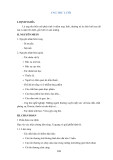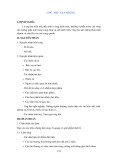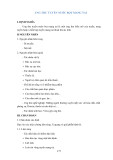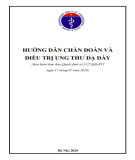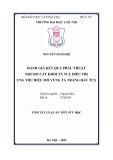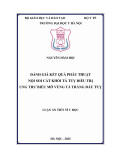
TNU Journal of Science and Technology
230(01): 353 - 359
http://jst.tnu.edu.vn 353 Email: jst@tnu.edu.vn
LAPAROSCOPY AND DOXORUBICIN INJECTION SURGERY SUPERFICIAL
BLADDER CANCER TREATMENT AT YEN BAI PROVINCE GENERAL HOSPITAL
Vu Duy Tan1*, Nguyen Manh Chien1, Nguyen Trung Hieu2,
Tran Lan Anh1, Diem Son1, Le Manh Hung2, Nguyen Huy Hoang3
1Yen Bai Provincial General Hospital, 2Health service of Yen Bai province, 3VietDuc University Hospital
ARTICLE INFO
ABSTRACT
Received:
20/8/2024
This study aims to evaluate the results of laparoscopic tumor resection
surgery and Doxorubicin injection to treat superficial bladder cancer at Yen
Bai Provincial General Hospital. We performed a retrospective description
of 31 patients with superficial bladder cancer who underwent initial
endoscopic tumor resection and postoperative Doxorubicin injection
between January 2018 and December 2023. The results showed that the
average age of the subject group was 58.58 ± 8.9 years old; Men make up
the majority (83.9%), women (16.1%), the male/female ratio is 5.2/1. The
most common symptom is hematuria in 25/31 patients (80.1%).
Preoperative diagnostic ultrasound detected 20/31 patients (64.5%). CT
Scanner can detect tumors in 100% of patients. Cystoscopy results showed
that the majority of patients had a tumor, 20/31 (64.5%). The average
surgical time was 42.7 ± 11.8 minutes. There were 1/31 patients with
bleeding complications after surgery (3.2%). Postoperative pathology
showed that the invasive stage was mainly T1 in 19/31 patients (61.3%).
Evaluation of results when discharged from the hospital was Good 96.8%
(30 cases), average 3.2% (1 case). 100% of patients were supplemented with
Doxorubicin pump, 20/31 patients (64.5%) complied with treatment.
Follow-up recurrence after 1 year was 2/31 patients (6.5%). From there, it
was found that treating superficial bladder cancer with laparoscopic tumor
resection and Doxorubicin injection is a safe and effective method.
Revised:
17/11/2024
Published:
19/11/2024
KEYWORDS
Laparoscopic tumor resection
Bladder
Carcinoma
Pathology
Chemical pump
PHẪU THUẬT CẮT U NÔI SOI VÀ BƠM DOXORUBICIN ĐIỀU TRỊ UNG
THƯ BÀNG QUANG NÔNG TẠI BỆNH VIỆN ĐA KHOA TỈNH YÊN BÁI
Vũ Duy Tân1*, Nguyễn Mạnh Chiến1, Nguyễn Trung Hiếu2,
Trần Lan Anh1, Diêm Sơn1, Lê Mạnh Hùng2, Nguyễn Huy Hoàng3
1Bệnh viện Đa khoa tỉnh Yên Bái, 2Sở Y tế tỉnh Yên Bái, 3Bệnh viện Hữu nghị Việt Đức
THÔNG TIN BÀI BÁO
TÓM TẮT
Ngày nhận bài:
20/8/2024
Nghiên cứu ngày nhằm mục tiêu đánh giá kết quả phẫu thuật nội soi cắt u và
bơm Doxorubicin điều trị ung thư bàng quang nông tại Bệnh viện Đa khoa tỉnh
Yên Bái. Chúng tôi thực hiện mô tả hồi cứu với 31 người bệnh ung thư bàng
quang nông được nội soi cắt u lần đầu và bơm Doxorubicin sau phẫu thuật trong
khoảng thời gian từ tháng 01/2018 đến tháng 12/2023. Kết quả cho thấy, độ
tuổi trung bình của nhóm đối tượng là 58,58 ±8,9 tuổi; nam giới chiếm đa số
(83,9%), nữ giới (16,1%), tỉ lệ nam/nữ là 5,2/1. Triệu chứng thường gặp nhất
là tiểu máu 25/31 (80,1%). Siêu âm chẩn đoán trước mổ phát hiện 20/31
(64,5%). Chụp CT Scanner phát hiện được u ở 100% bệnh nhân. Kết quả nội
soi bàng quang, đa số bệnh nhân có một u 20/31 (64,5%). Thời gian phẫu thuật
trung bình là 42,7 ± 11,8 phút. Có 1/31 bệnh nhân biến chứng chảy máu sau
mổ (3,2%). Giải phẫu bệnh sau mổ giai đoạn xâm lấn chủ yếu là T1 có 19/31
(61,3%). Đánh giá kết quả khi ra viện: Tốt 96,8% (30 ca), trung bình 3,2% (1
ca). 100% bệnh nhân được bổ trợ bằng bơm Doxorubicin, có 20/31 (64,5%)
tuân thủ điều trị. Theo dõi tái phát sau 1 năm là 2/31 (6,5%). Từ đó thấy rằng
điều trị ung thư bàng quang nông bằng phẫu thuật cắt u nội soi và bơm
Doxorubicin là phương pháp an toàn và hiệu quả.
Ngày hoàn thiện:
17/11/2024
Ngày đăng:
19/11/2024
TỪ KHÓA
Cắt u nội soi
Bàng quang
Ung thư biểu mô
Giải phẫu bệnh
Bơm hóa chất
DOI: https://doi.org/10.34238/tnu-jst.10982
* Corresponding author. Email: duytank43a@gmail.com











